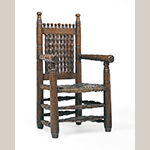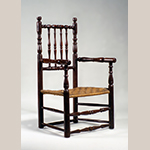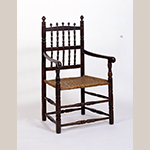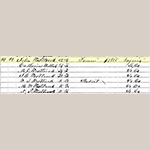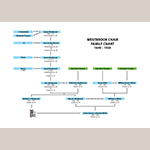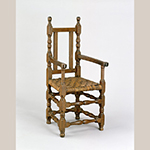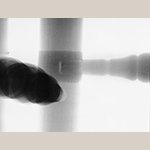The monumental increase in the online availability of archives and other primary sources has completely revolutionized American decorative arts research. The efforts of the past to find even the most basic facts required massive investments of time and travel—today, such information is accessible with just a few key strokes. At the same time, the relatively weak and few finding aids of archives and other repositories have been supplanted by massive scanning and indexing projects, often full-text keyword searchable. The result is that today’s researchers can quickly and easily find information that was elusive to their predecessors—even those scholars working as recently as a decade ago. An additional result is that the re-examination of provenance with these tools can shift the profile of unique objects within the field of southern decorative art.
An excellent example of this transformation in material culture research is the attribution of a seventeenth-century American turned armchair in the Museum of Fine Arts Houston’s Bayou Bend Collection (Figure 1).[1] Published by Bradford Rauschenberg and John Bivins in their exhaustive and iconic work, The Furniture of Charleston 1700-1820, the chair in question can be traced to the estate of James Garner LaFayette White of Chester, South Carolina.[2] Given the overt Continental aspects of the chair, Rauschenberg and Bivins concluded that the object was connected to the Huguenot settlement of the French Santee in the late seventeenth century.[3]
This writer has never been convinced about the chair’s Lowcountry attribution nor a late seventeenth-century date. With complete recognition of the constraints placed upon Rauschenberg and Bivins by publication deadlines and the enormous scope of their work, the time has come to re-assess this important, early turned armchair. By sourcing genealogical records that were not readily available to Rauschenberg and Bivins and analyzing cultural and circumstantial evidence, including a more nuanced understanding of Dutch influence in North America, this research note re-attributes the chair as a product of the Chesapeake region and dates it earlier than the settlement of South Carolina—and establishes it as the earliest extant southern chair, and potentially even as early as some of the chairs in the collection of the Pilgrim Hall Museum, Plymouth, Massachusetts.[4]
— ♦♦◊♦♦ —
The dates given for the chair by Rauschenberg and Bivins, 1685-1700, are situated in the late end of the Baroque period and do not reflect the chair’s decidedly earlier style, which incorporates late medieval and mannerist sensibilities.[5] [6] In fact, prior to Furniture of Charleston, the chair was published in a 1998 MESDA newsletter as South Carolina in origin and dating to the period of 1640-1660. That earlier period is consistent with the chair’s design, but it must be observed that South Carolina was not settled until 1670 and that the Huguenots did not settle the Santee until almost two decades later.[7] By the time Rauschenberg and Bivins published the chair in Furniture of Charleston, they had perceived the necessity of assigning dates that conformed to South Carolina history—however incongruent those dates were with the chair’s style. Indeed, to support their hypothesis, the authors illustrated two related Chesapeake chairs in Furniture of Charleston (Figures 2 and 3), a red flag emphasizing that no related Continental turned chairs made in South Carolina were extant.[8]
The central and most compelling argument for re-attribution of the chair (aside from stylistic affinities with related Chesapeake work) can be found in the genealogy of its owner, James Garner Lafayette White. Rauschenberg and Bivins wrote that the “line of descent before J.G.L. White’s lifetime is unclear, but tradition associates members of the family with the Lowcountry” and, although “no family ties with the early Lowcountry settlers have been documented, at least one family name, Westbrook, occurs in seventeenth-century Charleston.”[9] The authors must have focused on the Westbrook name because all lines of J.G.L. White’s paternal ancestry lead directly to Irish-born great- or great-great grandparents, most of whom were born in Ireland after 1750 and participated in the late eighteenth-century Scotch-Irish migration to America. Clearly, his father’s antecedents provide no avenue for descent of a seventeenth-century American chair displaying Continental features.
J.G.L. White’s maternal grandmother’s family, the Stephensons or Stinsons, also go immediately to Irish-born immigrants of the third quarter of the eighteenth century.[10] This family’s history even referenced J.G.L. White as possessing an original royal land grant in their tight-knit, much-intermarried Scotch-Irish community—a claim supported by a White Family history, which also referenced Mr. White’s possession of the heirloom land grant. [11] [12] Clearly, neither family historian saw any need to reference an old chair owned by Mr. White that was both unconnected to their families and stylistically outside of their Scotch-Irish frame of reference.
The first clue of an ancestral line that could accommodate the inheritance of a seventeenth-century American object was found through J.G.L. White’s maternal grandfather. White’s mother, Mary E. Westbrook (1828-1887), is listed in the 1850 Federal Census, Chester District, SC, in the household of her father, John Westbrook (1787-1860), who is clearly recorded as having been born in Virginia (Figure 4). John Westbrook’s earliest paternal ancestor in America was James Westbrook (1649-1711), who first appeared in Charles City County, Virginia, records in 1679 as a juryman (Figure 5).[13] By the time of his death, James Westbrook’s residence was located in Bristol Parish in Prince George County, Virginia, on the south side of the James River.[14] For the next one hundred years, James Westbrook’s descendants inhabited various parts of Southside Virginia. By 1723, his son Samuel Westbrook (d. 1761) had moved to Isle of Wight County, Virginia, and, in 1741, patented 900 acres located on the north side of the Meherrin River.[15] At the time of his death, Samuel bequeathed 300 acres of this land to his son James (d. 1773) and his grandson Jacob (d. 1827).[16] It was around 1793 that Jacob Westbrook sold the land inherited from his grandfather and, with his wife Nancy (d. 1843) and young son John, packed his family’s belongings—including the armchair—and moved to Chester County, South Carolina.
A compelling hypothesis for J.G.L. White’s acquisition of the chair exists in the estate records of his childless uncle, William S. Westbrook. White was appointed administrator of his uncle’s estate on 21 May 1903. The inventory of the estate included “1 chair (big)” valued at $1.00, but at the estate sale White purchased “1 arm chair for $13.25”.[17] Apparently, a lively competition for family heirlooms among Westbrook descendants at the estate sale is reflected in the high price that White paid for the chair.
While it is true that some early turned armchairs (i.e., “Great Chairs”) can be demonstrated to descend paternally, it cannot be assumed to always be the case.[18] In every generation behind John Westbrook, the maternal lines lead to a doubling of direct ancestors. Clearly these families are in the gene pool of southeastern Virginia.[19] By the generation of James Westbrook (1649-1711), J. G. L. White would have about a hundred direct ancestors who well could have owned the early turned armchair. It is a nearly unavoidable conclusion that the chair almost certainly descended to White through his Virginia-born maternal grandfather, John Westbrook, and perhaps directly in the Westbrook line.
— ♦♦◊♦♦ —
A number of other, more circumstantial, observations about the chair contribute to its Chesapeake attribution. Chesapeake turned chairs of the late seventeenth century and early eighteenth century almost universally display characteristics that could have evolved from this chair. In other words, this chair has a style context in the Chesapeake—it has none in the Lowcountry. The only extant example of an early Lowcountry South Carolina chair, now in the Colonial Williamsburg collection (Figure 6), is notably akin to examples from France. The South Carolina chair is in the later Baroque style that would likely have been transplanted by French Santee Huguenots.[20]
While it is recognized that the medieval tradition from which early turned chairs grew was almost a universal style in Europe, the use of turned over-hanging arms is, at an early date, mostly connected to Continental Europe and rare in Britain and New England.[21] The early turned armchair, “feels” more Dutch than French, at least judging by chairs we think to be made in the later seventeenth century. The presence and impact of Dutch settlers and Dutch traders in the Chesapeake as early as the 1620s has been documented by Robert Leath.[22] The Huguenots were generally much later settlers that likely met with an established Continental chair tradition in Virginia, one that was probably transmitted from the Netherlands via the large trade in chairs that was pursued by Dutch merchants.[23]
The use of cherry wood was widespread in seventeenth-century Continental European furniture and in Virginia chairs, although not recorded in Carolina Lowcountry records until much later.[24] Rauschenberg and Bivins were puzzled by the use of cherry on the early turned armchair, noting that “no cherry seating furniture has been found in Charleston inventories earlier than the mid-eighteenth century.”[25] Thus, the choice of wood used to make the chair fits within a Chesapeake context but not one in the Lowcountry. Cherry is also meaningful from a technical standpoint. The use of cherry wood on Continental and Continentally derived American furniture probably prompted turners to use a center bit—as was used on this chair—instead of the more common to Anglo practice use of a spoon or pod bit (Figure 7). The center bit was preferred for use on cherry because the wood was prone to splintering, which was minimized by the center bit’s tapered point.[26] It is unlikely that a Lowcountry chairmaker, who infrequently used cherry wood, would have possessed the technical knowledge to employ a center bit over the more common spoon or pod bit.[27] [28]
Some formal qualities of the turned armchair chair provide strong hints to an earlier date than the late seventeenth century.[29] The consistent thickness of all components and especially the compression of negative space relate the piece to late sixteenth- and early seventeenth-century European examples. The exuberance of the pervasive overall turned ornament closely relates to Dutch turning of the same period.[30] On the other hand, the turned chairs of the late seventeenth century, both American and Continental, have somewhat more spare turning (if often more sculptural) and less compressed negative space. While the merits of finding a datable meaning in the thickness of components of turned chairs has been systematically questioned and debunked, as a rule of thumb this author holds that there is a tendency for chairs made in the first half of the seventeenth century to be thicker and heavier than their counterparts in the later seventeenth century. The backs of turned chairs yield a similar division, i.e., chairs with backs that display pervasive turned ornament and highly compressed negative space tend to be earlier chairs. While not reliable for dating solely in themselves, these observations taken in context with other evidence support an early date span for the chair in question.[31]
— ♦♦◊♦♦ —
The early turned armchair that is the subject of this research note could be attributed to Chesapeake Virginia solely based on the more recent re-examination of its genealogical context. The chair’s Continental style and wood usage, which are consistent with a Virginia chair vernacular, and the absence of any late seventeenth-century Lowcountry genealogical or style context, support a Chesapeake attribution. Moreover, the chair likely predates South Carolina settlement. For all of those reasons, the evidence is sufficient to publish a re-attribution of the Westbrook family chair to the Chesapeake region of Virginia, made circa 1640-1660.
The Westbrook family chair belongs to its age and to every succeeding age that preserved it. It conditioned the pioneer period of the Chesapeake as well as the Southern Piedmont world to which it was brought in the late eighteenth century. The probable date span of the piece identifies it as the earliest known southern chair. Its importance, and its value to future research, is indicated by the fact that it is conceivable that the chair could date as early as New England chairs in Pilgrim Hall.[32]
Good scholarship is not necessarily definitive; it is successful if it moves the dialogue forward in a meaningful direction. In that sense, the previous attribution of the Westbrook family chair made by Rauschenberg and Bivins can be seen as good scholarship, and the re-attribution by this writer aspires to the same. It is hoped that other scholars add to the rich story that can be woven from this chair’s internal and contextual evidence.
Dale L. Couch is the Curator of Decorative Arts, Henry D. Green Center for the Study of the Decorative Arts, at the Georgia Museum of Art. He can be contacted at [email protected].
The author wishes to extend thanks to Gary Albert, Peter Follansbee, Erik Goldstein, Greg Jarrell, Steven Pine, Robert Trent, Brenda P. Wade, and the staff of the Probate Court of Chester County, South Carolina. Special thanks is due Robert Leath for both encouraging this project as well as for his assistance in research.
[1] Bradford L. Rauschenberg and John Bivins Jr., The Furniture of Charleston, 1680-1820, Vol. 1: Colonial Furniture (Winston-Salem, NC: MESDA, 2003), 16-23, Fig. E-1. John Bivins was the primary scholar responsible for the analysis of the early turned work in this publication.
[2] “Rauschenberg and Bivins, 17. The authors go on to call attention to a land grant to Caleb Westbrook in 1680. This Westbrook appears to be unconnected to James Garner LaFayette White.
[3] John Bivins provided this information to the author during the March 1998 MESDA Turned Furniture Symposium. At that time the author inspected the chair both with Bivins and independently. Bivins had worked extensively with chairs from the Chesapeake region that shared stylistic vocabulary and he had attributed those chairs to Huguenot influence from Manikin Town and related settlements.
[4] For examples of early American turned chairs in the Pilgrim Hall Museum collection, see http://www.pilgrimhallmuseum.org/ce_funiture.htm (accessed 22 January 2015).
[5] The use of the terms “Baroque” and “Mannerist” can be contentious, especially as regards American vernacular products. While this author aligns very much with Robert Trent in use of the term “Mannerist” for New England objects, which have overtly manipulated decorative forms quoted from classical sources, I have reservations about its use in connection to a vernacular chair that bears few if any classicizing elements and whose aesthetic message is stability. For the purposes of this article, I resort to the use of “early” and “later” Baroque periods, though in fact art historians often divide the epoch into three divisions that include early, high, and late academic Baroque. For a discussion of these terms, see Glenn Adamson, “Mannerism in Early American Furniture: Connoisseurship, Intention, and Theatricality,” American Furniture, 2005, edited by Luke Beckerdite (Milwaukee, WI: Chipstone, 2005); online: http://www.chipstone.org/html/publications/2005AF/Adamson/Adamsindex.html (accessed 2 January 2015). See also, Eric Gronning, “Early New York Turned Chairs: A Stoelendraaier’s Conceit,” American Furniture, 2001, edited by Luke Beckerdite (Milwaukee, WI: Chipstone, 2001); online: http://www.chipstone.org/article.php/592/American-Furniture-2001/Early-New-York-Turned-Chairs:–A-%3Cem%3EStoelendraaier’s%3C/em%3E-Conceit (accessed 2 January 2015).
[6] Researching early turned chairs is frustrated by the lack of published Continental examples with sound provenance and datable events. While there is no set modality by which we can precisely date the features of the chair in question, several scholars agree that intuitively it seems to date mid seventeenth century or earlier. In fact, Robert Leath asserted that the chair could actually display late sixteenth-century style. Certainly it can be dated as early as any American context can provide. For a discussion of early chair dating and technology, see Robert F. Trent and John D. Alexander, “American Board-Seated Turned Chairs, 1640–1740” American Furniture, 2007, edited by Luke Beckerdite (Milwaukee, WI: Chipstone, 2007), 83-109.
[7] For Huguenot settlement in South Carolina, see Walter Edgar, South Carolina: A History (Columbia: University of South Carolina, 1998), 51. Even in the 1690s and into the first decade of the eighteenth century, it is unlikely that the Huguenots would have been able to dedicate the time and effort away from establishing agriculture and ensuring survival to create and consume the kind of luxury object represented by a “Great Chair” (see endnote 13 for more information about the Great Chair).
[8] Rauschenberg and Bivins, 21, Figs. E-1h and E-1i.
[9] Ibid, 17.
[10] “Stinson” is the equivalent of Stephenson in lowland Scots language.
[11] See The Stephenson Family History by J. C. Stephenson (online: http://archive.org/stream/stephensonfamily01step/stephensonfamily01step_djvu.txt [accessed 2 January 2015]). Section 101 of this book has the following:
Mary Elizabeth Westbrook married William Alex-
ander White. Mr. White owned a large farm, three
miles south of Chester, South Carolina. On this farm
he reared a large and respectable family. Their son,
James G. L. White, now owns and lives on the original
White estate. It consists of four hundred acres that
has been in the family for one hundred and forty-five
years. The land was granted to Mr. White’s grand
ancestor in 1762, by the crown of England. The con-
sideration was ten shillings for a hundred acres. When
the land was surveyed it was guessed off with given
metes and bounds, always good measure thrown in.
The purchaser did the most of the guessing. J. G. L.
White has the original deed by which the crown of
England conveyed this land to his great-grandfather.
[12] Bonner Dale White, comp. and ed., et. al., The White Family: A Genealogical Historical Sketch of the White family From the Time of John White of Antrim County, Ireland, 1720 to the Time of His Descendants of the Present Day, 1968 (Chester, SC: n.p., 1932).
[13] Margaret McNeill Ayres, comp., Charles City County, Virginia, Order Book, 1676-1679 (Memphis, TN: M. M. Ayres, 1968), 102. On 3 June 1679, Westbrook served on a jury with Captain John Hamlin, John Hodges, Hercules Flood, Francis Leadbetter, Edward Burchett, John Woodley, Abraham Odum, William Hunt, William Hopkins, John Smith, and his brother-in-law, Maximillian Mansfield. Four months later, Westbrook and Hercules Flood were appointed to administer the estate of another brother-in-law, Thomas Mansull (Mansfill, Mansfield), while Maximillian Mansull (Mansfill, Mansfield) presented an account for the funeral expenses (Ibid, 113). On 9 January 1697, James Westbrook married a second time to Elizabeth Puckett of Henrico County, whose family the Pucketts and Womacks had lived on the south side of the James River since the mid seventeenth century (Lewis William Burton and Robert Alonzo Brock, Annals of Henrico Parish [Richmond, VA: Williams Printing, 1904], 227).
[14] Will of James Westbrook, proved 8 September 1711, in Benjamin B. Weisiger, Prince George County, Virginia, Wills & Deeds 1710-1713 (Richmond, VA: B. B. Weisiger, 1992), 83. In his will, James named his widow, Elizabeth (Puckett) Westbrook, plus sons Samuel, William, John, and James, and daughters Margaret and Elizabeth. James Westbrook’s approximate birth year is revealed in a 1694 deposition in which he is recorded as being 45 years old, see Deposition of James Westbrook, recorded 1 December 1694, Henrico County, Virginia Record Book, Book 5 (1688-1697), p. 533.
[15] Land grants to Samuel Westbrook, 5 September 1723 and 15 October 1741, Virginia Colonial Land Office Patents, 1623-1774, Library of Virginia, Archives, Richmond, VA. Online: http://lva1.hosted.exlibrisgroup.com/F/2D1TLHVDCRY8D512N891C2V5FN8EJ1BUIKNIJAAHHTTM4MUX8T-00132?func=full-set-set&set_number=002856&set_entry=000006&format=999 and http://lva1.hosted.exlibrisgroup.com/F/2D1TLHVDCRY8D512N891C2V5FN8EJ1BUIKNIJAAHHTTM4MUX8T-00782?func=full-set-set&set_number=002876&set_entry=000005&format=999 (accessed 2 January 2015).
[16] Will of Samuel Westbrook, proved 13 August 1761, Southampton County, Virginia, Wills, Book 1, p. 390. Samuel Westbrook’s will included grandson Jacob along with sons Samuel, James, and William, plus daughters Ann, Mary Turner, Martha Lowe, and Mansfill Gray. The use of the surname Mansfill (Mansull, Mansfield) as a daughter’s first name is further proof that James Westbrook’s first wife was one of Thomas and Maximillian Mansfield’s sisters.
[17] Estate packet of W. S. Westbrook, apartment 177, package no. 1377, Chester County Court of Probate, Chester, South Carolina.
[18] The term “Great Chair” denotes a chair design that translates social authority into wood. It was large and often elaborately carved, designed to magnify the head household’s importance. Other family members would be seated in less impressive chairs, or, more often, on benches. It should be noted, however, that the term “Great Chair” does not appear in South Carolina documents before 1820. Bradford Rauschenberg, “Documentary Evidence for Furniture Forms and Terminology in Charleston, South Carolina, 1670-1820,” MESDA Journal, 2013, online: https://www.mesdajournal.org/2013/documentary-evidence-furniture-forms-terminology-charleston-south-carolina-ii/#SeatChairGeneral (accessed 30 December 2014).
[19] The group predictably pursued endogamous marriages. Intermarriages between Carolina Lowcountry and Virginia families were extremely rare in America’s early period. It would be a safe assumption that most of John Westbrook’s maternal lines will prove to have Chesapeake origins in the seventeenth century.
[20] Although this chair has an early attribution to South Carolina, it was first published in a query in The Magazine Antiques, August, 1926 in a context suggesting that it was at that time in Virginia. However, Paul Burroughs published the chair in Southern Furniture (Richmond, VA: Garrett and Massie, 1931) with a South Carolina attribution. Burroughs is likely to have known the object’s recovery history. For a recent analysis of this chair see: Ronald L. Hurst and Jonathan Prown, Southern Furniture 1680-1830: The Colonial Williamsburg Collection (New York: Harry Abrams for the Colonial Williamsburg Foundation, 1997), 52-54.
[21] Robert F. Trent and Karin Goldstein, “Notes about New ‘Tinkham’ Chairs,” American Furniture, 1998, edited by Luke Beckerdite (Milwaukee, WI: Chipstone, 1998); online: http://www.chipstone.org/article.php/348/American-Furniture-1998/Notes-about-New-“Tinkham”-Chairs (accessed 2 January 2015). In fact, the ubiquitous overhanging turned arm is the unifying aspect of great expanses of southern chair history. Hurst and Prown, 63; Dale L. Couch, “Confluence of Regional Cultures in the Savannah River Basin: Reflections of Settlement Patterns in the Decorative Arts” in The Savannah River Valley to 1865: Fine Arts, Architecture, and Decorative Arts, edited by Ashley Callahan (Athens, Georgia Museum of Art, 2003), 62.
[22] Robert A. Leath, “Dutch Trade and Its Influence on Seventeenth-Century Chesapeake Furniture,” American Furniture, 1997, edited by Luke Beckerdite (Milwaukee, WI: Chipstone, 1997); online: http://www.chipstone.org/article.php/270/American-Furniture-1997/Dutch-Trade-and-Its-Influence-on-Seventeenth-Century-Chesapeake-Furniture (accessed 2 January 2015).
[23] Robert Trent recollects from his examination of the chair that the coves of the posts appeared to have a residual dark pigment that was possibly applied while the piece was on the lathe. Trent points out that this practice is associated with Dutch spinning wheels. Steven Pine, Senior Conservator of Decorative Arts at the Museum of Fine Arts, Houston, examined the chair’s surface and related the following in an email to the writer dated 30 January 2015:
Would the applied coloration be applied to only coves and thin skew “V” cuts highlighting the balls? The dark is found in both. There are passages of darker matter in the recesses of the turnings but there is an inconsistency that gives me pause. The existing finish has been supplemented over time and although is old certainly appears to have been evenly applied over areas of wear. The dark matter could be more than one material and it could be part of the original design decoration. Some could be intentionally pigmented but much of it reads more like old oxidized oil heavy varnish that was not removed during a selective cleaning sometime in the past. Only microscopy will clear it up. Location of the dark material (both where it is and where it is missing) hints at it being an old varnish but I’m open to learning more.
Clearly, microscopic surface analysis will be necessary to resolve the meaning of this surface variation.
[24] A search of the Rotterdam Museum’s collection resulted in numerous examples of turned chairs or framed chairs that date late sixteenth through the seventeenth century and have turned components that are made of cherry wood; online: http://museumrotterdam.nl/en/ (accessed 2 January 2015).
[25] Rauschenberg and Bivins, 18. Furniture made from cherry wood was not recorded in South Carolina until 1748. Rauschenberg, “Documentary Evidence…”; online: https://www.mesdajournal.org/2013/documentary-evidence-furniture-forms-terminology-charleston-south-carolina-ii/#SeatChairGeneral (accessed 30 December 2014).
[26] Rauschenberg and Bivins observed that a center bit was used on the chair in the drilling of a mortise. Apparently mistakenly measured, it was abandoned and left open. This is a fairly frequent mistake observed in early turned chairs. The bit used for that mortise was clearly a center bit. Rauchenberg and Bivins, 22.
The phrase “center bit’s tapered point” appeared in this article originally and unintentionally as “center bit’s tapered screw head.” The author did not note the mistake until contacted by Peyton Collie who, quite rightly, had reservations about a screw-tipped center bit pre-dating the eighteenth century; however, there is evidence that a center bit with an un-threaded tapered tip pre-existed the eighteenth century as early as the sixteenth century. Erik Goldstein, Curator of Mechanical Arts & Numismatics at the Colonial Williamsburg Foundation, is presently compiling evidence for center bits pre-dating the eighteenth century and the topic merits an independent monograph. Furniture historians apply the term “center bit” to both tapered-point and screw-head variations. Contemporary woodworkers almost invariably use the term “center bit” to refer to a bit with a threaded screw head. Goldstein has discovered evidence of the term in use before 1720 that might indicate that it was applied to the earlier form of bit. See endnote 28 for additional information about early center bits.
[27] Furniture maker and scholar Peter Follansbee of Plimoth Plantation, Massachusetts, expressed dismay at the use of cherry wood on the chair because he observed that the wood was very difficult to work. Follansbee is trained in making furniture with the Anglo preference of oak and ash. Peter Follansbee conversed with the author at the “Turned Furniture Seminar” held at MESDA in March of 2014.
[28] For a discussion of center bit use by early American woodworkers, see Benno M. Forman, American Seating Furniture 1630-1730: An Interpretive Catalogue (New York: W. W. Norton & Company, 1988), 54, 255-256. Also, furniture scholar Robert Trent points to center bit use in creating arm mortises in cane chairs of the seventeenth century.
[29] Using formal elements to positively date seventeenth-century turned chairs is difficult, if not impossible, because reliable dating schema for early turned chairs has yet to be established through an extensive review of Continental examples, especially those with dateable context.
[30] For Dutch examples, see Loek van Aalst and Annigje Hofstede, Noord-Nederlandse meubelen van ranaissance tot vroege barok 1550-1670 (Houten, The Netherlands: Hes & De Graaf, 2011), 364-369.
[31] Benno Forman and others have demonstrated the futility of using stock thickness as a sole demonstration of age. Forman himself argues that the massive thickness of early three post chairs was due to the fact that they had wood seats and hence the seat lists had to be level with each other to accommodate the seat, which was set in them as a chamfered panel (Forman, 72-73). That may well explain the origin of the use of the thick turned elements, but it does not preclude the use of thick posts in examples that do not have three posts. In fact, numerous variations are known with very thick posts. Overall, they appear to be constituted of largely early examples. It is likely, whatever function or structural origin this feature had, at some points thick turned elements were deployed for stylistic impact. Given the hierarchical or status value ascribed to early chairs, it is not surprising that massive dimensions and solidity were used to convey the importance of the sitter.
[32] The earliest turned chairs of Plimoth and Massachusetts Colonies tend to be dated in contemporary scholarship 1640-1660. Should they happen to date on the later end of that period and the Virginia chair under study should happen to date on the earlier end of its spectrum, then it would likely be the earliest American chair. This is expressed as a potential for the object, not as a conclusive fact. In fact, the writer anticipates that more seventeenth century chairs will emerge with a Virginia attribution.
© 2014 Museum of Early Southern Decorative Arts

